- Home
- About
- About SCMS
- Directors
- Artists
- Vera Beths
- Steven Dann
- Marc Destrubé
- James Dunham
- Mark Fewer
- Eric Hoeprich
- Christopher Krueger
- Myron Lutzke
- Marilyn McDonald
- Douglas McNabney
- Mitzi Meyerson
- Pedja Muzijevic
- Anca Nicolau
- Jacques Ogg
- Loretta O'Sullivan
- Lambert Orkis
- Paolo Pandolfo
- William Purvis
- Marc Schachman
- Jaap Schröder
- Andrew Schwartz
- William Sharp
- Ian Swensen
- Lucy van Dael
- Ensembles
- Concerts
- The Collection
- Recordings
- Education
- Donate
In its efforts to realize the concept of a ‘Living Museum,’ the Smithsonian Institution has launched a campaign to bring new dynamics to the place of music in the museum . . . It is our hope that through the offerings of the Smithsonian Collection of Recordings we are encouraging other museums to tear down the barricades that now stand between the musical artifacts in their collections, and the performers and listeners among their supporters. Similarly, we hope to encourage American musicians to broaden their knowledge of and expertise in the performance practices of the past.
James Morris, Director, Smithsonian Division of Performing Arts (1978)
The Smithsonian Collection of Recordings issued a number of important box sets and single CDs from the late 1970s until 1990. Some of these have been re-released on various commercial labels, but many are currently out of print. Since they may still be found in many libraries, as well as occasionally on line through third-party retailers, and since they document the early maturity of “authentic performance practice” in the United States, they are catalogued here. Instruments used from the Smithsonian Collection are identified in each instance.
Jacques Duphly: Music for Harpsichord (N004).
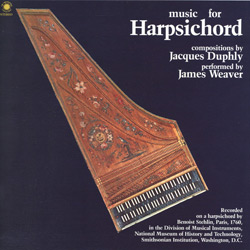 |
James Weaver performing on the Smithsonian’s 1760 Benoist Stehlin harpsichord. Recorded 1977 (LP only).
|
Works of Johann Sebastian Bach, vol. 1 (comprising N3008, N3012, and N3016; issued 1978 on LP and cassette):
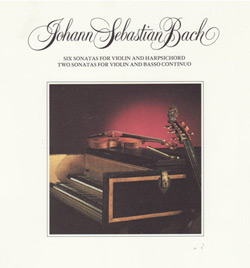 |
Six Sonatas for violin and harpsichord; Two Sonatas for violin and basso continuo (originally issued on Cambridge Records, 1974). James Weaver, harpsichord by Johannes Daniel Dulcken (Antwerp, 1745); Sonya Monosoff, violin by John Marshall (London, 1759); Judith Davidoff, viola da gamba by Barak Norman (London, 1718). |
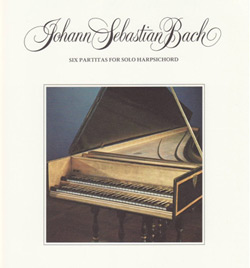 |
Six Partitas for Solo Harpsichord (Clavierübung I). James Weaver, harpsichord by Johannes Daniel Dulcken (Antwerp, 1745). Recorded 1978 |
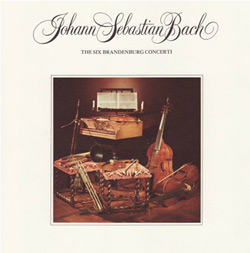 |
The Six Brandenburg Concerti. Musicians of Aston Magna, directed by Albert Fuller. Recorded 1977. |
Works of Georg Frideric Handel (comprising N023, N025, and N029; issued 1982 on LP and cassette):
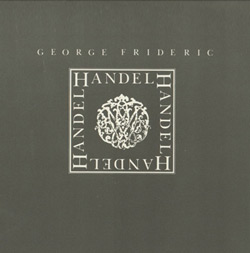 |
Eight Sonatas for Diverse Instruments. Marilyn McDonald & Nancy Wilson, violins; Robert Willoughby, flauto traverso; James Caldwell, baroque oboe; Kenneth Slowik, violoncello by J. B. Tononi (Bologna, 1740) and viola da gamba by Barak Norman (London, 1718); James Weaver, harpsichord by Burkat Shudi (London, ca. 1743). Recorded 1981.
|
 |
Seven Concerti Grossi, Op. 3. The Smithsonian Chamber Players, directed by James Weaver. Among the instruments played by the 24 members of the Chamber Players are a violin labeled Nicolo Amati (Cremona, 1670); a violin by Antonio Gragnani (Livorno, 1783); a violin by Jacobus Stainer (Absam, ca. 1680); a violin by Ferdinando Gagliano (Naples, 1780); a viola by Sebastian Klotz (Mittenwald, ca. 1740); a viola by Gennaro Gagliano (Naples, 1762); a violoncello by J. B. Tononi (Bologna, 1740); a harpsichord by Nicolaus DeQuoco (Italy, 1694); an anonymous Italian harpsichord (1693); and a chamber organ by John Snezler (London, 1760). Recorded 1979.
|
 |
Messiah. The Smithsonian Chamber Players, the American Boy Choir, with tenors and basses of the Norman Scribner Chorus, conducted by James Weaver, with Carole Bogard, soprano; Elvira Green, alto; Jeffrey Gall, countertenor; Charles Bressler, tenor; and Leslie Guinn, bass. Recorded 1980.
|
Works of Wolfgang Amadeus Mozart (comprising ND031-1; ND031-2; ND031-3; ND031-4; and ND031-5; issued 1986 on LP, cassette, and CD):
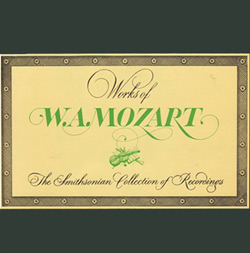 |
Orchestral Works. Serenade in D Major, k 204/213a; Concertone in C Major, K190/186E; Sinfonia Concertante in E-flat Major , K364/320d; Concerto in A Major for basset clarinet, K622. Jaap Schröder & Marilyn McDonald, violins; Marilyn McDonald, viola by Gennaro Gagliano (Naples, 1762); Lawrence McDonald, basset clarinet, with the Smithsonian Chamber Orchestra, directed by Jaap Schröder. Recorded 1986. The Concertone and Sinfonia Concertante were re-issued as Vol. 1 of deutsche harmonia mundi’s Mozart Edition, VD 77500. |
|
Chamber Music. Quartet in D Major for flute and strings, K285; Quintet in E-flat Major for horn and strings, K407/386c; Quartet in G Minor for fortepiano and strings, K478; Quartet in E-flat Major for fortepiano and strings, K478; Trio in E-flat Major, K498, Kegelstatt; Eine kleine Nachtmusik, K525; Ein musikalischer Spaß, K522; Quintet in A Major for clarinet and strings K581; Quartet in D Major, K499, Hoffmeister. Members of the Smithson String Quartet—Jaap Schröder, violin by the Brothers Amati (Cremona, ca. 1620); & Marilyn McDonald, violin from the shop of Nicoló Amati (Cremona, ca. 1670); Judson Griffin, viola by Gennaro Gagliano (Naples, 1762); Kenneth Slowik, violoncello by J. B. Tononi (Bologna, 1740)—with James Weaver, fortepiano by Jean-Louis Dulcken (Munich, ca. 1789); Christopher Krueger, flute; Lawrence McDonald, clarinet; Lowell Greer & R. J. Kelley, horn; Melissa Graybeal, viola; Richard Myron, doublebass. Recorded 1985-86.
|
Beethoven: Early Years through the Eroica (comprising ND0321; ND0322; ND0323; and ND0324; issued 1988 in CD, LP, and cassette)
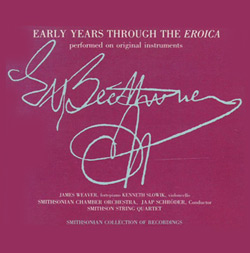 |
Symphonies 1, 2, & 3 (Eroica). The Smithsonian Chamber Orchestra, directed by Jaap Schröder. Recorded 1987. The Symphonies 1 & 3 were re-issued as BMG/deutsche harmonia mundi RD 77030.
|
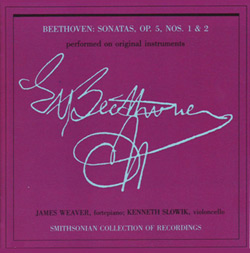 |
The Two Sonatas, Op. 5. James Weaver, fortepiano; Kenneth Slowik, violoncello. Recorded 1988.
|
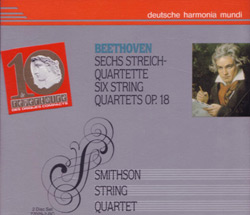 |
The Six String Quartets, Op. 18. The Smithson String Quartet (Jaap Schröder & Marilyn McDonald, violins; Judson Griffin, viola; Kenneth Slowik, violoncello). Recorded 1987. Re-issued as EMI/deutsche harmonia mundi 7-49046-2; as BMG/deutsche harmonia mundi 77029-2-RC; and as SONY/deutsche harmonia mundi 88697-57616-2.
|
Works of Johann Sebastian Bach, vol. 2 (comprising ND0381; ND0382; and ND0383; issued 1990 on CD, LP, and cassette):
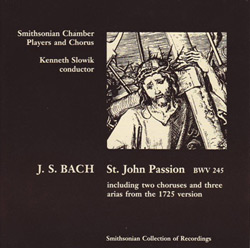 |
St. John Passion, BWV 245 (including two choruses and three arias from the 1725 version). The Smithsonian Chamber Players and Chorus, conducted by Kenneth Slowik. Recorded 1989.
|
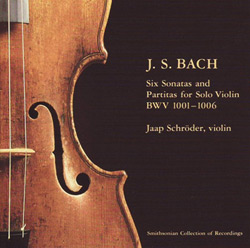 |
Six Sonatas and Partitas, BWV 1001-1006. Jaap Schröder, violin. Recorded 1984-85. Re-issued as ADDA 581134/35; as SMC 1, Smekkleysa AC 99071; and as NAXOS 8.557563-64.
|
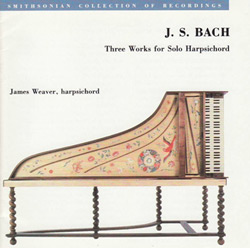 |
Concerto in D Minor after Marcello, BWV 974; Italian Concerto, BWV 971; French Ouverture, BWV 831. James Weaver, harpsichord. Recorded 1987.
|
Selected Piano Music of Louis Moreau Gottschalk (ND033).
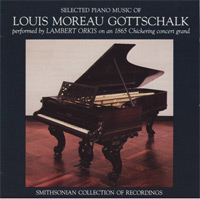 |
Lambert Orkis, piano by Chickering (Boston, 1865). Recorded 1982. Re-issued as Bridge 9206.
|
Antonin Dvořák: Dumky Trio, Op. 90; Bedrich Smetana: Piano Trio in G Minor, Op. 15 (ND034).
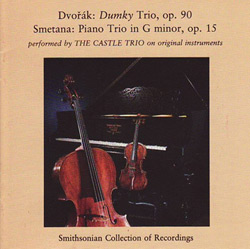 |
The Castle Trio: Lambert Orkis, piano by Steinway & Sons, the Paderewski (New York, 1892); Marilyn McDonald, violin; Kenneth Slowik, violoncello by Antonio Stradivari, the Marylebone (Cremona, 1688). Recorded 1986.
|
Arcangelo Corelli: The Twelve Trio Sonatas of Opus 3 (1689) (ND035).
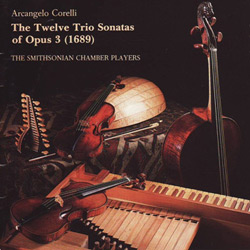 |
The Smithsonian Chamber Players: Jaap Schröder & Marilyn McDonald, violins; Kenneth Slowik, violoncello; Konrad Junghänel, theorbo; James Weaver, organ. Recorded 1987. Re-released in 2913 on the Friends of Music label as FoM 36-805.
|
Sweet Was The Song: Traditional Carols sung by Max van Egmond, baritone, with the Smithsonian Chamber Players under the direction of Kenneth Slowik (ND040).
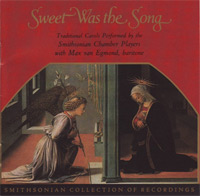 |
Mary Anne Ballard, viols; James Caldwell, oboe; Dennis Godburn, bassoon & recorder; Shelly Gruskin, muzette, recorders, flute, & percussion; Stanley King, oboe, oboe da caccia, & recorder; Michael Lynn, recorder; Marilyn McDonald, violin; Catharina Meints, viol; Linda Quan, violin; Scott Reiss, recorders; Alice Robbins, viol; Marc Schachman, oboe & oboe d’amore; Kenneth Slowik, viols, keyboard, & percussion; Margriet Tindemanns, viol; James Weaver, keyboard. Recorded 1990. Re-issued in France by Reader’s Digest in the series Les plus grands voix du monde, 3545.16/1.2.3, and on the Friends of Music label (in 2017) as FofM 12-025.
|



 Lambert Orkis recorded the eight selections by Gottschalk utilizing an 1865 Chickering instrument with a light, quick action and what Orkis calls “a wet sound” issued by small dampers. The effects can be startlingly rich, often suggestively erotic sounds propped by a deep bass. Great stuff, wonderfully mounted.
Lambert Orkis recorded the eight selections by Gottschalk utilizing an 1865 Chickering instrument with a light, quick action and what Orkis calls “a wet sound” issued by small dampers. The effects can be startlingly rich, often suggestively erotic sounds propped by a deep bass. Great stuff, wonderfully mounted. Sweet Was The Song uses period instruments for material dating mostly from the Renaissance and Baroque eras. Some of the material is familiar, but all of it should be. The superb singing of Dutch baritone Max van Egmond in several languages, Kenneth Slowik’s charming arrangements, and the ensemble’s idiomatic playing make this disc very special.
Sweet Was The Song uses period instruments for material dating mostly from the Renaissance and Baroque eras. Some of the material is familiar, but all of it should be. The superb singing of Dutch baritone Max van Egmond in several languages, Kenneth Slowik’s charming arrangements, and the ensemble’s idiomatic playing make this disc very special.